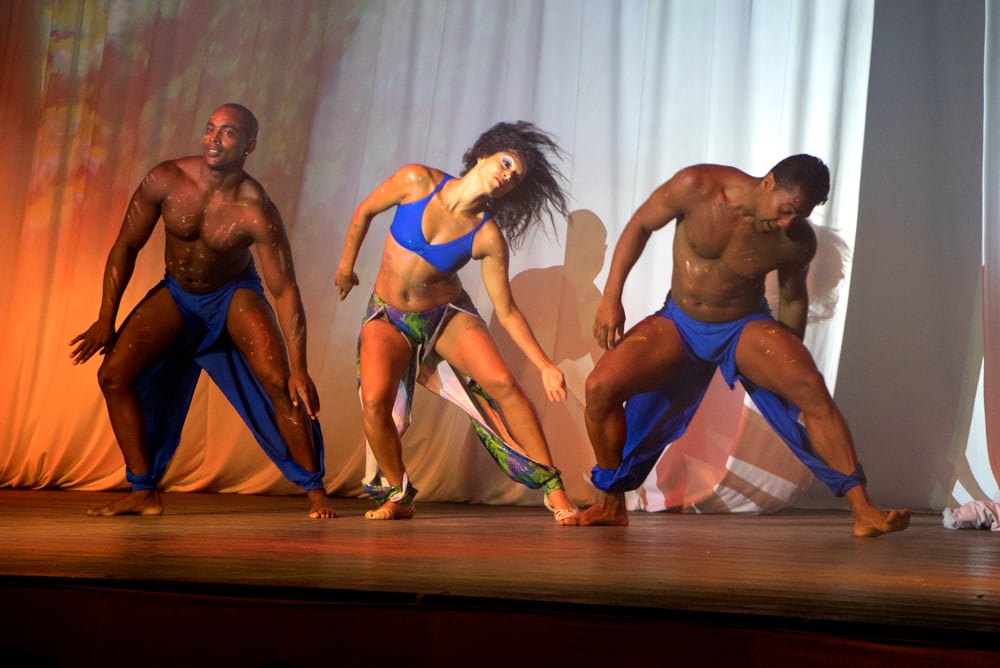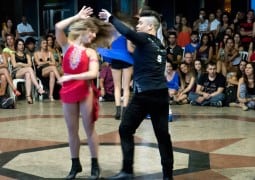Origins of our Dance

Pam Connolly
Dr Pamela Stephenson Connolly is a psychologist, author of seven books, and a dance promoter. She is the organizer of the Brazouka Beach Festival, Co- Producer of Brazouka stage show, Creator of Lamba Crew, Director of Pasion Dance Company and Studio, Director of the Master Braz Certificate Courses, and Founder of the American Lambada Organization.
A question was posed regarding the origins of our dance. Where? When? Who?
History is important. But great dances are not created overnight by one person, or in one place at one time. These are dynamic, creative processes. In the case of Lambada – and subsequently Brazilian Zouk- we have to look at its creation as being developed from several different dances and movements. Africa gave us many of these movements. One has only to watch the movements of sacred orixá dances, as well as popular African dances such as Lundu, Carimbo and Maxixe to recognize the major dance influences that led to the later crystallization of the early forms of Lambada – including hip and head movements. Forro also influenced the development of Lambada and – according to at least one Salvadoran scholar – so did polka. The point is that before Lambada music arrived, all these aforementioned dances were flourishing especially in parts of Brazil that had populations with African heritage. So the Lambada music and these dances traveled around the country from northern parts of Brazil like Belem and became melded together in certain centers – notably in Porto Seguro where there were spaces for the development of the dance such as the Lambada school in the church square in Arraial d’Ajuda and at the Boca da Barra in Porto Centro. It was in Porto Seguro that the dance began to take real form, with a recognizable style and rules and competitions. Of course, it was danced in the bordellos of Porto, which meant that the dance had a notoriety right from the beginning. But this ‘forbidden’ quality of the dance (which was also present in its predecessors Lundu and Maxixe) only served to make it more popular. People came to Porto Seguro from many other parts of Brazil to watch and dance Lambada at the famous cabana ‘Boca da Barra’. Eventually Lambada music and dance gained worldwide popularity when the group ‘Kaoma’ was formed to promote it and became enormously successful. I really want to stress that although it may have seemed to Rio or São Paulo dancers that Lambada lost its popularity – but in Porto Seguro it NEVER DID. Bahianos have been dancing this beautiful dance in its purest contemporary form since the beginning – often facing enormous opposition and judgement which exists even today. Dance spaces were burned down, lambadeiros were judged to be immoral and ostracized. Fortunately, the Porto Seguro government has recently declared Lambada to be an important cultural entity. This has only taken forty years!
But if a dance gains sweeping popularity as Lambada did, it will always have to rely on the continued creation of new music. For various reasons known best to the commercial music industry, after the demise of Kaoma Lambada music began to be replaced by different rhythms. Radio stations lost interest and moved on to the next craze. There were still many people who still wanted to dance Lambada but students in Rio and São Paulo became hungry for new styles and new music. Dance teachers in many places were losing money. So it is no surprise that Lambada metamorphosized into a more contemporary form and was repackaged as ‘Zouk’ – which happened to be the name of Caribbean music from Martinique and Guadalupe that had a similar rhythm to Lambada. They renamed classic Lambada steps – Lambada’s ‘Basic 6’ became ‘Lateral’. ‘Diagonal Twist’ became ‘Bonus’ etc etc. But it was still actually … LAMBADA. People with backgrounds in other dances – Renata Pecanha for example – added touches that brought a Contemporary Dance flavor to Lambada. It started to be danced slower, in a linear rather than circular pattern, more upright and with less movement in the hips, all of which was easier for people with European backgrounds. The more complex and difficult moves of Lambada such as Boneca – which was created by Master Didi and his then partner Rebecca Lang and subsequently developed by Master Braz and others in the Boca da Barra – were left behind. The fascinating ‘Desprezada’ was itself ‘ignored’! Why? Probably because it was considered too difficult for the masses and therefore not marketable. And the ‘Diagonale’ – a basic and essential element of Lambada that creates stability, beauty and an excellent preparation for turns – was also lost.
In reality, no one can be blamed for trying to repackage a beautiful dance, even though it involved a certain amount of ‘dumbing down’. Even the lack of acknowledgement that Brazilian Zouk was, at its foundation, Lambada, was understandable. Less forgivable, in my view, was – and is – the failure to acknowledge the essential African nature of the dance’s foundations and the African origin of its rhythms. Such a shocking omission may have been based in blatant racism.
Of course, some repackaging attempts simply involved renaming Lambada: ‘LambaZouk’, ‘Zouk-Lambada’ and many more. And there was a group of Caribbean dancers who had serious objections to ‘Zouk’ – the first new name for Lambada. People in Martinique and Guadalupe for example already enjoyed a local dance called ‘Zouk’ that was nothing like Lambada. So enter a consortium of individuals who chose the name ‘Brazilian Zouk’ (incidentally that occurred without consultation with the Bahian Masters who had created the original form of the dance).
To come full circle, I want to reiterate that all dances are dynamic; they will continue to develop and change. The developers of Brazilian Zouk were more privileged in terms of education and had better marketing skills than most Bahian lambadeiros so little wonder purer Lambada began to lose ground.
Today the majority of Brazilian Zouk students are young, educated and social network-savvy. The essential street-wise /beach-based/ sassy / extroverted / fast-paced/ sexually polarized elements of classic Lambada have morphed into the now popular and more physically conservative/ androgynous / lyrical / introverted/ trancy forms. And what was intuitive, innate and natural has, in some settings, become far more stylized and the subject of endless verbal analysis. But don’t get me wrong – many beautiful and interesting styles of dance have developed from Lambada, though, and some superb performers and teachers have emerged. And one can only admire the ability of leaders in those fields to engage students as they have done.
These days, Lambada is enjoying a resurgence in the United States and elsewhere, and its original name has been reclaimed. Brazilian Zouk Dancers are interested in exploring more variety in terms of dance ‘energia’ – and it is noteworthy that Brazilian Zouk Jack & Jill competitions in Northern America now comprise a faster section.
There are considerable challenges involved in dancing Lambada well – including the need for heightened musicality at fast tempo, the ability to swap partners and dance with more than one person at a time, extraordinary athleticism, and an acutely exquisite partner connection even without physical touch. Nevertheless, today die-hard Lambadeiros and ‘Lamba’ newcomers alike bask in the pure pleasure of their extraordinary dance, and hungrily seek its fun and potency wherever they can.
For those who have so far been exposed only to more contemporary forms of Lambada – acknowledging the roots of Brazilian Zouk is not only ethically essential; the truth is that understanding the basic forms and patterns of classic Lambada leads to a far better ability to understand and execute Brazilian Zouk. It is no mistake that some of the innovators of new styles – Adílio Porto and Renato Veronezi for example – were originally
fantastic classical lambadeiros.
It seems smart and logical that those who started with Brazilian Zouk should be trying to learn classic Lambada as well, right? After all, its of similar importance as learning Classical Ballet first before attempting Modern Ballet…
And for those of you for whom learning the roots of your dance seems out of reach or too hard, at least take comfort in knowing that- as a Brazilian Zouker – you ALREADY dance Lambada.
You may also like...
Sorry - Comments are closed







